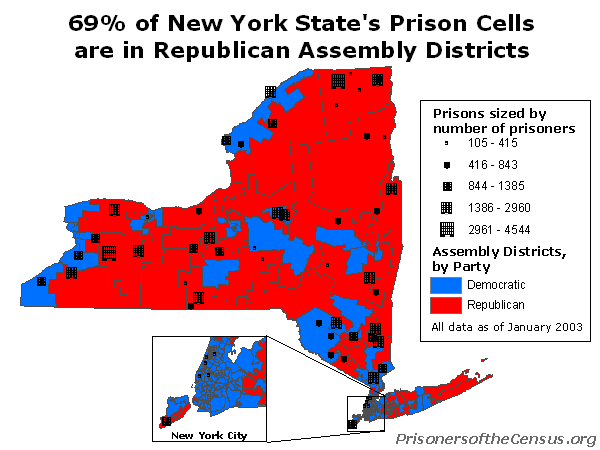by Peter Wagner,
August 9, 2004

District 34 as shown on the New York Senate’s official map. It took me over a year and to find Rikers Island on this map because the boundaries were unrecognizable. (Larger version.)

I made this map. The Bronx-Westchester border is emphasized and the major highways added.

This map includes the major parks. (Note how the parks “orphan” portions of the district and make it less contiguous.)

Adding in the open water reveals the actual shape of the district.

This oddly shaped district includes the nearly 13,000 detainees on Rikers Island who are legally resident elsewhere. (Larger version.)
New York State Senate District 34 was discussed in the column last week. This district straddles the border between Bronx County in New York City and suburban Westchester County. If the New York City residents in state prisons had been counted at home rather than in upstate prisons, the Bronx side of the border might have been populous enough to dominate the district. District 34 also has a remarkable shape and story. The New York Times described the shape as “a doughnut that has had a bite taken out of it and then been run over by a car”. The district was apparently created to include many white communities, while excluding the African-American community in the center as well as the home of a political opponent of the incumbent. (See original map at right.)
The district configuration was a hotly contested issue at the redistricting taskforce meeting in the Bronx that I testified at in March 2002. I maintained that even though the U.S. Census currently counts prisoners as if they were permanent residents of the state prison, the New York State Constitution requires an adjustment to Census Bureau data. The prisoners should be counted back at their home addresses because their legal residence does not change during incarceration. Without this population adjustment, New York City loses 43,740 residents to the upstate areas that contain state prisons.
Because the district maps prepared for the hearing did not include cultural and geographic features, no one present noticed the population elephant hiding in the corner. This article suggests an alternative way of looking at district data and the question of whether District 34 represents a single cohesive community.
The second map at right approximates the layout of the official District 34 map, with the local major highways added and a dark border between the Bronx and Westchester Counties. (Westchester is to the north of the dark line.) The third map includes the major parks and the fourth map includes the open water.
The grey oval at the bottom of the last map is the population elephant: Rikers Island, the largest penal colony in the world. Senate District #34 snakes down through the Bronx to include the 12,780 people on Rikers Island. (According to Census data, 7,897 are Black and 3,443 are Hispanic.) Very few of the Rikers Island detainees are permanent residents of District 34, and yet they were counted there for redistricting purposes.
Two-third of the people on Rikers Island are pre-trial detainees. These detainees retain the right to vote but are required to do so via absentee ballot back in their home districts. Any persons actually serving felony time on Rikers have lost their right to vote. None of the incarcerated people counted on Rikers Island are voting there.
Senate District 45 in northern New York includes 12 state prisons and the largest number of state prisoners, but Rikers Island, by itself, has just a few hundred less. And while the average state prisoner has been in their current prison for almost 7 months, the average stay on Rikers Island is only 39 days. And unlike state prisons which shuffle prisoners around frequently until their sentences expire, the next stop after Rikers is frequently home.
Upstate Senators have boasted that while they do get letters from prisoners with complaints, they are free to ignore these “constituents”. But the Senator who represents District 34 has an even better deal: None of the 13,000 phantom residents of Rikers Island cast a vote there, and the senator from District 34 is about the last person a temporary detainee will think to write to.
After all, District 34 is a district dominated by Westchester County. The only way on or off Rikers Island is the bridge that connects it to Queens.
Large jail populations counted in the Census can be just as important as large prisons when it comes to diluting the votes of neighborhoods with large numbers of incarcerated people.














